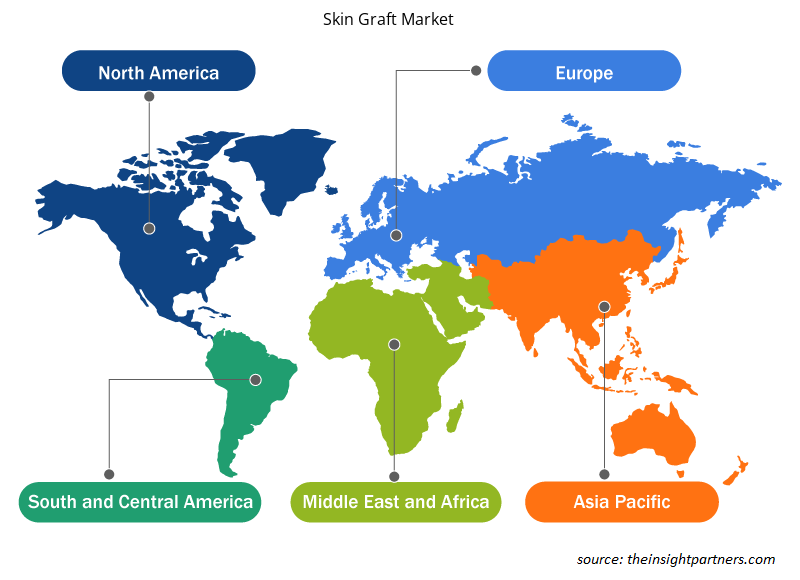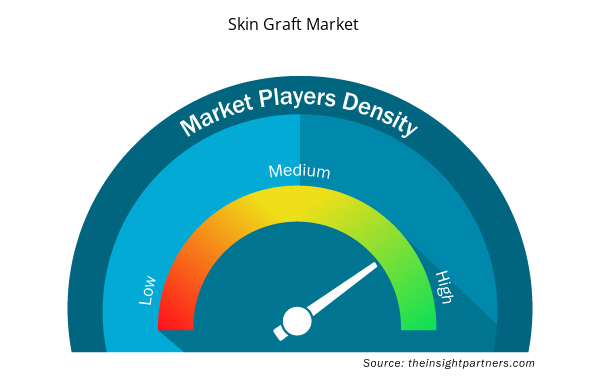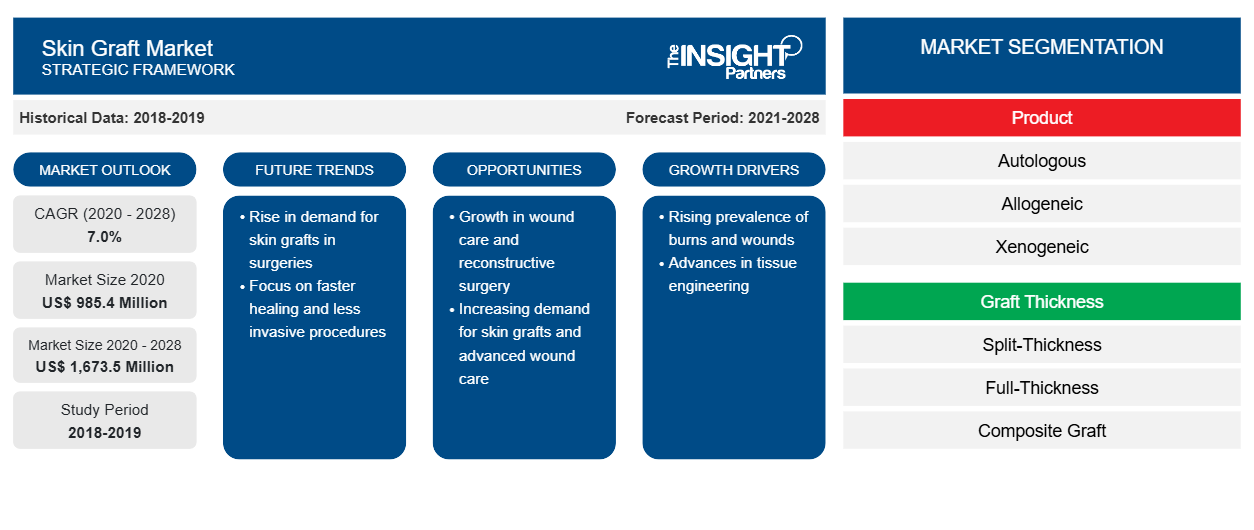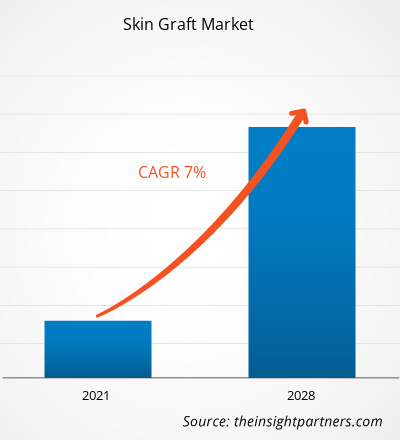2020 年皮肤移植市场价值为 9.854 亿美元,预计到 2028 年将达到 16.735 亿美元;预计 2021 年至 2028 年的复合年增长率为 7.0%。
皮肤移植是一种使用各种类型的皮肤移植进行皮肤移植的手术。皮肤移植也用于治疗大面积伤口或创伤和烧伤。在皮肤移植手术中,皮肤的一小块被从患者身体的一部分切除,并通过手术附着或移植到从患者身体另一部分皮肤切除的身体受影响区域。皮肤贴片被移植或附着到受伤部位或烧伤部位。皮肤移植市场
根据产品、移植厚度、应用、设备、最终用户和地区进行细分。市场根据地区分为北美、欧洲、亚太地区、中东和非洲以及南美和中美洲。该报告提供了对皮肤移植市场的深入分析和见解,重点关注各种参数,例如市场趋势、技术进步、市场动态以及全球主要市场参与者的竞争格局分析。它还包括 COVID-19 大流行对所有地区市场的影响。由于 COVID-19 疫情爆发,各家医院都在救治感染者。此外,由于各种伤口护理中心都设在医院内。因此,大多数患者无法接受伤口护理治疗。~ 大约四分之一的患者能够接受伤口护理治疗,预计全美有近 670 万人正在等待伤口治疗。研究人员评估了与培养基或上呼吸道粘液混合的 SARS-CoV-2 和甲型流感病毒 (IAV) 在人体皮肤表面的稳定性,以及 80% (w/w) 乙醇对 SARS-CoV-2 和 IAV 的皮肤消毒效果。为了避免感染健康志愿者,研究人员使用原本用于皮肤移植的尸体皮肤进行了实验室实验。COVID-19 疫情的爆发对皮肤移植市场产生了深远的负面影响,影响了护理质量。
定制此报告以满足您的需求
您可以免费定制任何报告,包括本报告的部分内容、国家级分析、Excel 数据包,以及为初创企业和大学提供优惠和折扣
- 获取此报告的关键市场趋势。这个免费样品将包括数据分析,从市场趋势到估计和预测。
市场洞察
皮肤癌和糖尿病发病率上升
皮肤移植是皮肤癌术后的理想治疗方法。皮肤移植通常用于局部术后放射治疗 (PORT),以确保放射治疗期间形成的手术床闭合。根据英国癌症研究中心的数据,英国每年登记约 15,400 例黑色素瘤皮肤癌新病例,相当于每天新增 42 例。预计 2014 年至 2035 年间,英国黑色素瘤皮肤癌的发病率将上升 7%,到 2035 年将达到每 100,000 人 32 例。同样,根据国际癌症研究机构最近发布的统计数据,2020 年登记的新癌症病例为 1930 万例,不包括 1810 万例非黑色素瘤皮肤癌。因此,皮肤癌患病率的增加可能会在未来导致皮肤移植。
糖尿病是全球最常见的健康状况之一。根据国际糖尿病联盟 (IDF) 2019 年发布的《IDF 糖尿病地图集》第九版,全球约有 4.63 亿成年人患有糖尿病。预计到 2045 年,全球糖尿病患病人数将达到 7 亿,占全球中低收入国家糖尿病成年人的近 79%。在糖尿病患病人数中,2 型糖尿病的比例增长速度更快。根据 IDF 的数据,未来将有 3.74 亿人面临患 2 型糖尿病的风险。糖尿病患者的伤口愈合时间较长,如果伤口未在特定时间内愈合,则会增加皮肤感染的风险。约 25% 的糖尿病患者一生中可能会出现一次足部溃疡,通常需要高级糖尿病伤口护理。因此,通过皮肤移植来治疗或覆盖糖尿病足部溃疡以消除感染皮肤感染的机会的需求增加。因此,预计皮肤癌和糖尿病的高患病率将在不久的将来推动皮肤移植市场的发展。
基于产品的洞察
根据类型,皮肤移植市场细分为自体、同种异体、异种异体、假体和同种异体。自体部分在 2020 年占据了全球医药中间体市场的最大市场份额,预计同一细分市场的市场在 2021-2028 年期间将以最高速度增长。自体部分的市场增长可归因于自体移植的广泛使用,广泛用于治疗开放性烧伤和伤口。
基于应用的洞察
根据应用,皮肤移植市场细分为烧伤、大面积伤口、皮肤癌和其他应用。烧伤细分市场在 2020 年占据了最大的市场份额。预计同一细分市场在预测期内的复合年增长率最高。
公司通常采用合作伙伴关系、并购等无机策略来满足不断变化的客户需求并在全球范围内维护其品牌名称。在皮肤移植市场运营的市场参与者还采用产品发布和扩张等有机策略来扩大其全球业务范围和产品组合,并满足不断增长的需求。
皮肤移植市场区域洞察
Insight Partners 的分析师已详细解释了预测期内影响皮肤移植市场的区域趋势和因素。本节还讨论了北美、欧洲、亚太地区、中东和非洲以及南美和中美洲的皮肤移植市场细分和地理位置。

- 获取皮肤移植市场的区域特定数据
皮肤移植市场报告范围
| 报告属性 | 细节 |
|---|---|
| 2020 年市场规模 | 9.854 亿美元 |
| 2028 年市场规模 | 16.735 亿美元 |
| 全球复合年增长率(2020 - 2028) | 7.0% |
| 史料 | 2018-2019 |
| 预测期 | 2021-2028 |
| 涵盖的领域 | 按产品
|
| 覆盖地区和国家 | 北美
|
| 市场领导者和主要公司简介 |
|
皮肤移植市场参与者密度:了解其对业务动态的影响
皮肤移植市场正在快速增长,这得益于最终用户需求的不断增长,这些需求源于消费者偏好的不断变化、技术进步以及对产品优势的认识不断提高等因素。随着需求的增加,企业正在扩大其产品范围,进行创新以满足消费者的需求,并利用新兴趋势,从而进一步推动市场增长。
市场参与者密度是指在特定市场或行业内运营的企业或公司的分布情况。它表明在给定市场空间中,相对于其规模或总市场价值,有多少竞争对手(市场参与者)存在。
在皮肤移植市场运营的主要公司有:
- B. Braun Melsungen AG
- Integra 生命科学公司
- 施乐辉
- AVITA 医疗
- 美迪克斯
免责声明:上面列出的公司没有按照任何特定顺序排列。

- 了解皮肤移植市场顶级关键参与者概况
按产品
- 自体
- 同种异体
- 异种
- 假肢
- 同源
按移植厚度
- 厚度分层
- 全层
- 复合移植物
按应用
- 烧伤
- 大面积伤口
- 皮肤癌
- 其他应用
按设备
- 皮节
- 普通手术器械
- 耗材
- 其他市场
按最终用户
- 医院
- 门诊手术中心
- 皮肤科诊所
按地理位置
北美
- 我们
- 加拿大
- 墨西哥
欧洲
- 法国
- 德国
- 意大利
- 英国
- 西班牙
- 欧洲其他地区
亚太地区 (APAC)
- 中国
- 印度
- 韩国
- 日本
- 澳大利亚
- 亚太地区其他地区
中东和非洲 (MEA)
- 南非
- 沙特阿拉伯
- 阿联酋
- MEA 其他地区
南美洲和中美洲(SCAM)
- 巴西
- 阿根廷
- 其余的骗局
公司简介
- B. Braun Melsungen AG
- Integra 生命科学公司
- 施乐辉
- AVITA 医疗
- 美迪克斯
- 器官发生公司
- 组织再生集团
- 齐默邦美
- 德索特医疗
- 诺瓦格公司
- 历史分析(2 年)、基准年、预测(7 年)及复合年增长率
- PEST 和 SWOT 分析
- 市场规模价值/数量 - 全球、区域、国家
- 行业和竞争格局
- Excel 数据集



Report Coverage
Revenue forecast, Company Analysis, Industry landscape, Growth factors, and Trends

Segment Covered
This text is related
to segments covered.

Regional Scope
North America, Europe, Asia Pacific, Middle East & Africa, South & Central America

Country Scope
This text is related
to country scope.
常见问题
Skin grafting is a surgery involving the transplantation of skin using various types of skin graft. Skin grafts are also used to treat extensive wounding or trauma and burns. Skin graft is small patch of skin, which is removed from skin of the other part of the patients body by a surgery. The patch of skin is transplanted or attached to the injured sit or the burnt site.
The types of pharmacy automation equipment are autologous, allogeneic, xenogeneic, prosthetic, and isogeneic.
The growth of the market is attributed to Increasing numbers of burn injuries, and rising prevalence of skin cancer and diabetes. However, high cost of skin grafting procedures and alternatives for skin grafts hinders the market growth.
Trends and growth analysis reports related to Life Sciences : READ MORE..
The List of Companies - Skin Graft Market
- B. Braun Melsungen AG
- Integra Life Sciences Corporation
- Smith & Nephew
- AVITA Medical
- MiMedx
- Organogenesis Inc
- Tissue Regenix Group
- Zimmer Biomet
- De Soutter Medical
- Nouvag AG
The Insight Partners performs research in 4 major stages: Data Collection & Secondary Research, Primary Research, Data Analysis and Data Triangulation & Final Review.
- Data Collection and Secondary Research:
As a market research and consulting firm operating from a decade, we have published and advised several client across the globe. First step for any study will start with an assessment of currently available data and insights from existing reports. Further, historical and current market information is collected from Investor Presentations, Annual Reports, SEC Filings, etc., and other information related to company’s performance and market positioning are gathered from Paid Databases (Factiva, Hoovers, and Reuters) and various other publications available in public domain.
Several associations trade associates, technical forums, institutes, societies and organization are accessed to gain technical as well as market related insights through their publications such as research papers, blogs and press releases related to the studies are referred to get cues about the market. Further, white papers, journals, magazines, and other news articles published in last 3 years are scrutinized and analyzed to understand the current market trends.
- Primary Research:
The primarily interview analysis comprise of data obtained from industry participants interview and answers to survey questions gathered by in-house primary team.
For primary research, interviews are conducted with industry experts/CEOs/Marketing Managers/VPs/Subject Matter Experts from both demand and supply side to get a 360-degree view of the market. The primary team conducts several interviews based on the complexity of the markets to understand the various market trends and dynamics which makes research more credible and precise.
A typical research interview fulfils the following functions:
- Provides first-hand information on the market size, market trends, growth trends, competitive landscape, and outlook
- Validates and strengthens in-house secondary research findings
- Develops the analysis team’s expertise and market understanding
Primary research involves email interactions and telephone interviews for each market, category, segment, and sub-segment across geographies. The participants who typically take part in such a process include, but are not limited to:
- Industry participants: VPs, business development managers, market intelligence managers and national sales managers
- Outside experts: Valuation experts, research analysts and key opinion leaders specializing in the electronics and semiconductor industry.
Below is the breakup of our primary respondents by company, designation, and region:

Once we receive the confirmation from primary research sources or primary respondents, we finalize the base year market estimation and forecast the data as per the macroeconomic and microeconomic factors assessed during data collection.
- Data Analysis:
Once data is validated through both secondary as well as primary respondents, we finalize the market estimations by hypothesis formulation and factor analysis at regional and country level.
- Macro-Economic Factor Analysis:
We analyse macroeconomic indicators such the gross domestic product (GDP), increase in the demand for goods and services across industries, technological advancement, regional economic growth, governmental policies, the influence of COVID-19, PEST analysis, and other aspects. This analysis aids in setting benchmarks for various nations/regions and approximating market splits. Additionally, the general trend of the aforementioned components aid in determining the market's development possibilities.
- Country Level Data:
Various factors that are especially aligned to the country are taken into account to determine the market size for a certain area and country, including the presence of vendors, such as headquarters and offices, the country's GDP, demand patterns, and industry growth. To comprehend the market dynamics for the nation, a number of growth variables, inhibitors, application areas, and current market trends are researched. The aforementioned elements aid in determining the country's overall market's growth potential.
- Company Profile:
The “Table of Contents” is formulated by listing and analyzing more than 25 - 30 companies operating in the market ecosystem across geographies. However, we profile only 10 companies as a standard practice in our syndicate reports. These 10 companies comprise leading, emerging, and regional players. Nonetheless, our analysis is not restricted to the 10 listed companies, we also analyze other companies present in the market to develop a holistic view and understand the prevailing trends. The “Company Profiles” section in the report covers key facts, business description, products & services, financial information, SWOT analysis, and key developments. The financial information presented is extracted from the annual reports and official documents of the publicly listed companies. Upon collecting the information for the sections of respective companies, we verify them via various primary sources and then compile the data in respective company profiles. The company level information helps us in deriving the base number as well as in forecasting the market size.
- Developing Base Number:
Aggregation of sales statistics (2020-2022) and macro-economic factor, and other secondary and primary research insights are utilized to arrive at base number and related market shares for 2022. The data gaps are identified in this step and relevant market data is analyzed, collected from paid primary interviews or databases. On finalizing the base year market size, forecasts are developed on the basis of macro-economic, industry and market growth factors and company level analysis.
- Data Triangulation and Final Review:
The market findings and base year market size calculations are validated from supply as well as demand side. Demand side validations are based on macro-economic factor analysis and benchmarks for respective regions and countries. In case of supply side validations, revenues of major companies are estimated (in case not available) based on industry benchmark, approximate number of employees, product portfolio, and primary interviews revenues are gathered. Further revenue from target product/service segment is assessed to avoid overshooting of market statistics. In case of heavy deviations between supply and demand side values, all thes steps are repeated to achieve synchronization.
We follow an iterative model, wherein we share our research findings with Subject Matter Experts (SME’s) and Key Opinion Leaders (KOLs) until consensus view of the market is not formulated – this model negates any drastic deviation in the opinions of experts. Only validated and universally acceptable research findings are quoted in our reports.
We have important check points that we use to validate our research findings – which we call – data triangulation, where we validate the information, we generate from secondary sources with primary interviews and then we re-validate with our internal data bases and Subject matter experts. This comprehensive model enables us to deliver high quality, reliable data in shortest possible time.


 获取此报告的免费样本
获取此报告的免费样本